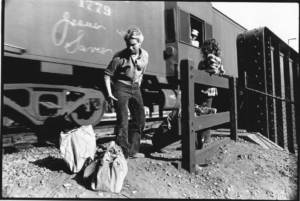My wife Wendy and I recently went to Cuba on a music tour which was organized by Wendy’s sister Nancy Covey, who operates Festival Tours International. It was a People-to-People delegation organized by Project Por Amor. At first, I thought that there would not be many chances to make photographs while riding across Cuba in a bus. Usually I pick the spots where I feel I will find the best subject matter, and not participate in an organized tour, so I had resolved to make the tour, more for the music than for the photos.
The trip on the bus across Cuba with many friends was a fine way to spend two weeks and see Cuba at the same time. The bus turned out to be a great way for me to photograph. I could relax on the bus and prepare myself for the next stop and all the subject matter that I found almost everywhere.Nancy knew that I would always be looking for subjects and told me that I could always go off by myself to photograph, but I stayed with the group more times than not and was also able to find subjects to work with. Subject is everywhere in Cuba. Nancy planned such great trip that I did not have to think much or worry about anything, because it was all taken care of by Nancy. All I had to do was think about photos and be back at the bus on time. The trip was wonderful and I made about 200 photos.
I have been back from Cuba for two weeks and in that time I have spent about 150 hours in the darkroom making prints from the six rolls of film that I used in Cuba. My friends who use digital cameras can have a good laugh knowing that I have spent the last two weeks in the darkroom making prints. I have made about 150 prints and now with Wendy’s help, we will put some of them up.
My approach to photographing in Cuba was to combine street photography with social documentary photography, which is why I carried two cameras. I have used Nikon F-3 film cameras for thirty years and I am too afraid to change over to digital and have to learn to be quick all over again. Also, the people who purchase my prints expect traditional fiber based silver prints, so I am still laboring with film. Part of the time, I carried three cameras, because I had done the foolish thing of bringing some color film with me. What was I thinking? I do not like color in my street or social documentary photography, because it is so hard to control in the real world. The person with the yellow hat will be seen first and the point of the photograph might be lost because of the distraction caused by a bright color. I use color when color is content, which is rarely ever found in street photography. I made about twenty color photos and felt silly making them. Who cares what color the car was as long as it’s shiny?
The Nikon F-3 camera was made for pro photographers more than thirty years ago. Pro cameras usually show 100% in the viewfinder, which is very important to me, because I do not like to crop. This is a very fine camera which is very durable and has the finest lenses that I have ever used. No one wants these gems and they can be had for $100.00 with lens. I still have a good laugh when I think that I am using one of the finest cameras ever made and I buy them for $100.00.
I do not enjoy using two cameras, because they slow me down. When I find a subject, I have to imagine it through a 55mm and a 28mm in order to decide which one to use. This is wasted time. Using just one camera with one lens solves this time problem. We must be quick. Using the two cameras worked out well for me. The streets in Cuba can be quite narrow and congested with life, so I used the 28mm much of the time. The 28mm is a sports car type of lens, in that it is very dangerous. The 28mm must be used up very close to the center of interest, or, the wide angle of view might provide too much information to the viewer, and the center of interest might get lost because of so much being visible in the frame. Up close, it is a valuable tool.
I tend to look for three things in a potential subject and then try to form some connection between these three elements, factors or details that when properly framed, make a visual statement about a subject or event in one well timed photograph. I found that the people of Cuba are lovely and will give the photographer no trouble at all. They are a relaxed and happy people and are very polite and easy to be around.
This photo was made while I played one of my favorite games, which is called the isolation challenge. The photographer must make a photo without changing position. This image was made from my seat at lunch with our group in a small fishing village. The image shows the condition of Cuba and the how the people are still rebuilding after the devastation to the southern part of the island during hurricane Sandy.
The photo of the young woman sitting under the photograph of an older woman was made from my chair at a musical event we all attended. This game forces the photographer to make the best of what is in the general area.




